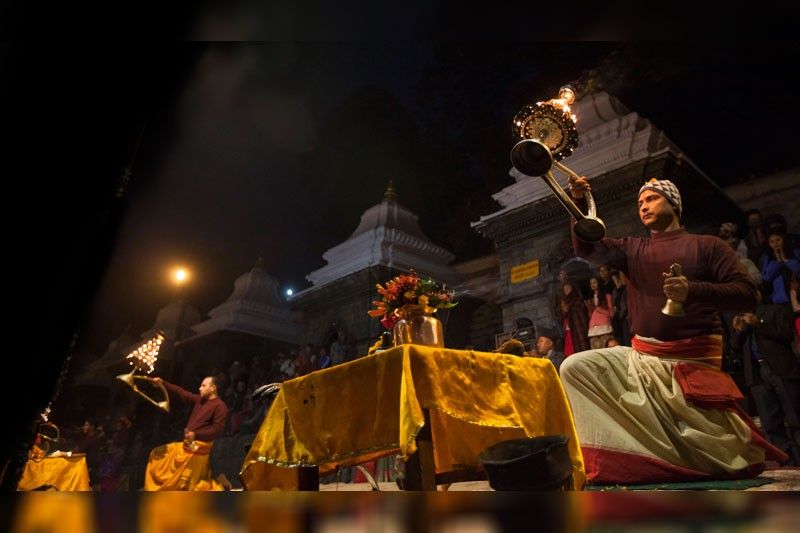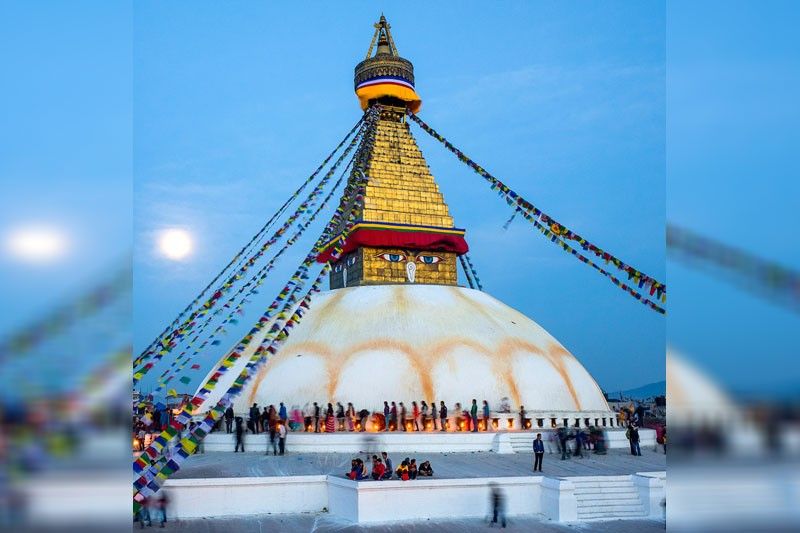Finding treasures for the spirit in Kathmandu

There was nothing like seeing Kathmandu firsthand. Standing before its sacred spaces, temples, and shrines and walking around the palace squares and pathways of its medieval cities harkened back to the days when the depictions of the sacred were the symbols of a culture and a people. I could still sense the people’s affinity to the spiritual and the sacred. Here, I found that art, religion, and everyday life were closely intertwined.
The Kathmandu Valley had been the political, economic, and cultural center of Nepal for some 1,500 years. Since the fourth century, the culture of Kathmandu had been shaped by Hinduism, Buddhism, influences from the local Newar community and Tibet.
In the 13th century, Kathmandu flourished alongside the city-states of Bhaktapur and Patan.

Götz Hagmüller, architect of the Patan Museum and one of the foremost guardians of Nepal’s cultural heritage, described the cultural significance of the Kathmandu Valley. In Patan Museum: The Transformation of a Royal Palace in Nepal, Hagmüller wrote, “This urban culture was, and still remains, a highly religious one. Some of the holiest, oldest and most venerated shrines and pilgrimage sites of the Hindu and Buddhist domains are located in the Valley, and its ruling elites were always associated with the divine.”

The indigenous people of the valley, the Newars, created much of the artwork and architecture of the Kathmandu Valley. Newari history dated back to the Licchavi period (circa 450-750). The flowering of their culture came in the 17th century when the valley was dominated by three city-states: Kathmandu, Patan, and Bhaktapur.
In 1769, Nepal was unified as a modern state under Prithvi Narayan Shah and Kathmandu emerged as the nation’s capital.
I began my journey in the Dwarika’s Hotel, an intimate enclave of Nepali-style brick buildings set around a courtyard. Woodcarvings from traditional homes embellished the facades of the structures. The hotel holds a collection of woodwork and houses a workshop to restore pieces collected from around the valley. In 2006, it was awarded a UNESCO Asia- Pacific Award for Cultural Heritage Conservation.
During my stay, I saw Hindus and Buddhists worship side by side in the spirit of openness. The Kathmandu Valley and its seven monument zones were designated as UNESCO World Heritage sites in 1979. These heritage sites told stories of man’s connection to the divine — how the divine in its many forms and manifestations served to guide, inspire, and give meaning to life.
Reading about Nepali life, I learned that ordinary people and lofty rulers turned to the gods, goddesses, and the deities to seek their providence, guidance, and grace. The Kings of the medieval Malla dynasty and the succeeding Shah dynasty put their fates in the living goddess Kumari — an embodiment of the mother goddess, Durga. It was believed that kings were invested with the powers and energies of the divine.
My first stop was the giant white stupa of Boudhanath, the oldest and largest Buddhist shrine along the Kathmandu-Tibet route. There, Buddhist temples and monasteries, homes, cafés, and shops brimming with ritual objects and local crafts stood side by side.
Boudhanath has provided shelter for Tibetans who have made Nepal their home since the late 1950s. Tibetans and devotees from around the world chanted mantras and spun prayer wheels as they sought blessing for themselves and all living beings. Prayer flags hung beneath the pinnacle of the stupa, signifying that one entered a field of blessings. First built in the fifth and sixth centuries, it has been restored many times since. The stupa was believed to be a wish-fulfilling jewel that granted answers to prayers brought before it.
At Kathmandu Durbar Square, I came to a place of worship, a gathering space, and a cultural center all at once. Most of the structures in this square were erected during the time of the Malla kings (1200-1768) who were prolific builders and patrons of the arts. Some 50 temples and monuments were said to occupy this vast space. Yet it was the depiction of the deities in their various forms, the elaborate woodcarvings, delicate wooden lattices, and embellishments on the window frames, doors, columns, and gateways that brought the talents and skills of the local Newari artisans and craftsmen to the fore. This royal square is home to the living goddess Kumari — a potent symbol of spirituality and syncretism in Nepal. The prepubescent goddess was chosen from among the girls of the Newari Buddhist community. Hindu and Buddhist priests made ritual offerings and said prayers for the protection of this young goddess.
At three in the afternoon, locals and tourists gathered in the courtyard of the Kumari house to catch a glimpse of the goddess, who sometimes appears from the second-floor window. I arrived just in time to see the Kumari. She looked down at the crowd with a stern gaze. Dressed in auspicious red, her lips were shaded bright red and her eyelids rimmed with kohl liner. In those moments, just as in ceremonial functions, the young girl ceased to be a child but became a powerful, living goddess who was believed to ensure the wellbeing of the nation, the king, and his people.
By nightfall, I headed for Pashupatinath to attend the evening aarti — an offering of lamplights, prayers, and devotional music to the Lord Shiva. Pashupatinath, Nepal’s most important Hindu temple, stood on the banks of the Bagmati, a sacred river that flowed into the Ganges. Though the temple grounds were dark and desolate, the sound of bells and ritual music drew us into the spirit of the offerings, which was joyous and soulful. The evening aarti brought the young and old to their feet as they danced to the feverish beat in the final moments of the aarti. Ritual offerings had long been central to the Hindu tradition as way of uniting oneself with the divine.
Over the next two days I visited the former royal cities of Bhaktapur and Patan. Around its palace squares, the glories of past kingdoms came to the fore. Walking around these cities, I couldn’t think of another place that exuded as much atmosphere — the architectural elements and the skill that marked each composition evoked the days when the pursuit of the arts and the depiction of the sacred were the expressions of a kingdom’s might.
Exploring Bhaktapur, felt like I had gone back to the days of the old trade routes, when trade gave way to cross-cultural exchanges. The palace square features temples built in the North Indian architectural style, primarily dedicated to Hindu gods and goddesses — all built around a 55-window palace of brick and wood.
Beyond the square, vendors sold fruits, spices, and vegetables, and storefronts were laden with a display of carpets, shawls, trinkets, textiles, and silverware.
In Bhaktapur and Patan, decorative motifs in carved wood adorned the pillars, window frames of homes and buildings along the narrow streets and alleys.
Patan was one of the oldest known settlements in the Kathmandu Valley where a community of artisans and craftsmen had thrived for centuries. Crowning the Patan Durbar Square was the Krishna Mandir Temple, built in the North Indian style and completed in 1637. Built entirely of carved stone, it was said to be the earliest stone temple of its kind in Nepal. The stone carvings on the upper floor beams depicted stories from the Mahabharata and events from the Ramayana, two great epics poems of India.
At the Buddhist monastery of Kwa Bahal, the facade of the temple in the inner courtyard was clad in gilded copper. The craftsmanship of the temple and the central shrine are thought to be the finest examples of repoussé metalwork in Nepal.
Before leaving Kathmandu, I visited Svayambhu Stupa, the oldest monument in the valley. I met Tsering Gellek, who spearheaded the 15th renovation of Svayambhu. The project had been envisioned by the Tibetan Lama Tarthang Tulku Rinpoche.
During our conversation, Tsering shared aspects about the sacred landscape of Svayambhu. As the site of the creation story of the Kathmandu Valley, it was deemed as the axis mundi (world center) of the valley. As important as the stories and legends about the sacred hill and the structures built above it, were energies of the hill itself that were said to be powerful and hold transformative and healing qualities. People since the earliest days knew how to find and harness these healing earth energies and built structures above them so that people could deepen their connection to the spiritual. Due to an ankle injury, I could not climb up the 300 steps to reach the stupa. But staying below on the hilltop area and knowing that the site radiated healing energies was already a blessing for me.
In Kathmandu, I had come face-to-face with a wealth of religious traditions. Here, I learned that there were many ways to see and appreciate the divine. I recalled the words of the Dalai Lama, who once said, “Every religion has certain unique ideas or techniques, and learning about them can only enrich one’s own faith.”
At the Kaiser Café in the Garden of Dreams, I gazed out to a neo-classical garden that dated back to the 1920s. An amphitheater, a lotus pond, and a pergola stood around flowering plants, hedges, and trees. It seemed a world away from the hive of activity beyond its gates. What I held close to heart were the sacred spaces of the Kathmandu Valley — places of refuge, where one could feel the presence of the divine amid the hustle and bustle of everyday life.



















